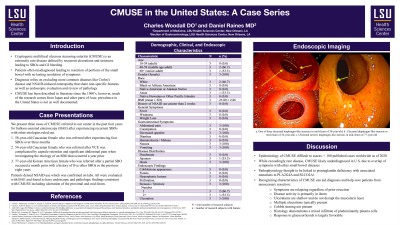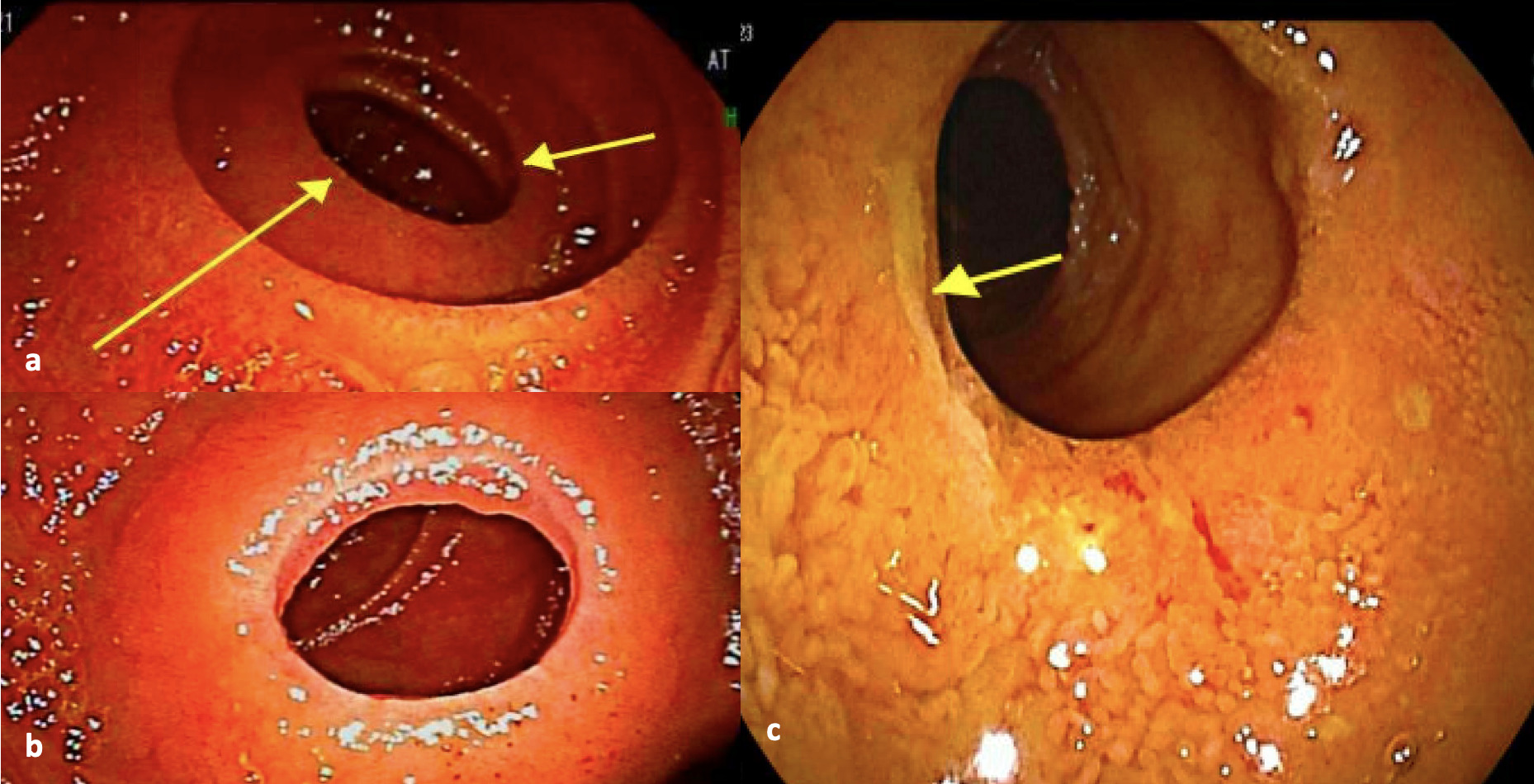Monday Poster Session
Category: Small Intestine
P3281 - CMUSE in the United States: A Case Series
Monday, October 28, 2024
10:30 AM - 4:00 PM ET
Location: Exhibit Hall E

Has Audio

Charles B. Woodall, DO
Louisiana State University Health Sciences Center
Covington, LA
Presenting Author(s)
Charles B. Woodall, DO1, Daniel Raines, MD2
1Louisiana State University Health Sciences Center, Covington, LA; 2Louisiana Health Sciences Center New Orleans, New Orleans, LA
Introduction: Cryptogenic multifocal ulcerous stenosing enteritis (CMUSE) is an extremely rare disease defined by recurrent ulcerations and strictures that lead to SBOs and GI bleeding. Patients are often misdiagnosed leading to resection of portions of the small bowel with no lasting resolution of symptoms. Diagnosis relies on excluding more common diseases like Crohn’s disease and NSAID-induced enteropathy that share non-specific features as well as endoscopic evaluation and review of pathology. CMUSE has been described in literature since the 1960’s, however, much of the research comes from Japan and other parts of Asia. Its presence in the United States is not as well documented.
Case Description/Methods: We present a series of three cases of CMUSE referred to our medical center in the past four years for balloon-assisted enteroscopy (BAE) after experiencing recurrent SBOs with other etiologies ruled out. Our first patient is a 58-year-old Caucasian female who was referred after experiencing four SBOs over three months. The second patient is a 54-year-old Caucasian female who was referred after VCE was complicated by capsule retention and significant abdominal pain when investigating the etiology of an SBO that occurred a year prior. The third patient is a 77-year-old Korean American female who was referred after a partial SBO occurred a month prior with a history of five other SBOs in the previous eight years. Patients denied NSAID use which was confirmed on labs. All were evaluated with BAE and found to have endoscopic and pathologic findings consistent with CMUSE including ulceration of the proximal and mid ileum.
Discussion: The epidemiology of CMUSE is difficult to assess as there were less than 100 published cases worldwide as of 2020. While still an exceedingly rare disease, CMUSE is likely significantly underdiagnosed in the U.S. due to the overlap of symptoms it shares with other diseases of the small bowel. Pathophysiology is thought to be linked to prostaglandin deficiency with associated mutations in PLA2G4A and SLCO2A1. Recognizing the following features of CMUSE can aid in diagnosis and help save patients from unnecessary resection: symptoms are relapsing regardless of prior resection, disease activity is primarily in the ileum, ulcerations are shallow and do not disrupt the muscularis layer, multiple ulcerations are typically present, cobble stoning is not present, histology demonstrates a mixed infiltrate of predominantly plasma cells, and response to glucocorticoids is largely favorable.

Note: The table for this abstract can be viewed in the ePoster Gallery section of the ACG 2024 ePoster Site or in The American Journal of Gastroenterology's abstract supplement issue, both of which will be available starting October 27, 2024.
Disclosures:
Charles B. Woodall, DO1, Daniel Raines, MD2. P3281 - CMUSE in the United States: A Case Series, ACG 2024 Annual Scientific Meeting Abstracts. Philadelphia, PA: American College of Gastroenterology.
1Louisiana State University Health Sciences Center, Covington, LA; 2Louisiana Health Sciences Center New Orleans, New Orleans, LA
Introduction: Cryptogenic multifocal ulcerous stenosing enteritis (CMUSE) is an extremely rare disease defined by recurrent ulcerations and strictures that lead to SBOs and GI bleeding. Patients are often misdiagnosed leading to resection of portions of the small bowel with no lasting resolution of symptoms. Diagnosis relies on excluding more common diseases like Crohn’s disease and NSAID-induced enteropathy that share non-specific features as well as endoscopic evaluation and review of pathology. CMUSE has been described in literature since the 1960’s, however, much of the research comes from Japan and other parts of Asia. Its presence in the United States is not as well documented.
Case Description/Methods: We present a series of three cases of CMUSE referred to our medical center in the past four years for balloon-assisted enteroscopy (BAE) after experiencing recurrent SBOs with other etiologies ruled out. Our first patient is a 58-year-old Caucasian female who was referred after experiencing four SBOs over three months. The second patient is a 54-year-old Caucasian female who was referred after VCE was complicated by capsule retention and significant abdominal pain when investigating the etiology of an SBO that occurred a year prior. The third patient is a 77-year-old Korean American female who was referred after a partial SBO occurred a month prior with a history of five other SBOs in the previous eight years. Patients denied NSAID use which was confirmed on labs. All were evaluated with BAE and found to have endoscopic and pathologic findings consistent with CMUSE including ulceration of the proximal and mid ileum.
Discussion: The epidemiology of CMUSE is difficult to assess as there were less than 100 published cases worldwide as of 2020. While still an exceedingly rare disease, CMUSE is likely significantly underdiagnosed in the U.S. due to the overlap of symptoms it shares with other diseases of the small bowel. Pathophysiology is thought to be linked to prostaglandin deficiency with associated mutations in PLA2G4A and SLCO2A1. Recognizing the following features of CMUSE can aid in diagnosis and help save patients from unnecessary resection: symptoms are relapsing regardless of prior resection, disease activity is primarily in the ileum, ulcerations are shallow and do not disrupt the muscularis layer, multiple ulcerations are typically present, cobble stoning is not present, histology demonstrates a mixed infiltrate of predominantly plasma cells, and response to glucocorticoids is largely favorable.

Figure: a. One of three ulcerated diaphragm-like stenoses in mid-ileum of 58-year-old female; b. Ulcerated diaphragm-like stenosis in mid-ileum of 54-year-old female; c. Ulcerated (yellow arrow) diaphragm-like stenosis in mid-ileum of 77-year-old female
Note: The table for this abstract can be viewed in the ePoster Gallery section of the ACG 2024 ePoster Site or in The American Journal of Gastroenterology's abstract supplement issue, both of which will be available starting October 27, 2024.
Disclosures:
Charles Woodall indicated no relevant financial relationships.
Daniel Raines indicated no relevant financial relationships.
Charles B. Woodall, DO1, Daniel Raines, MD2. P3281 - CMUSE in the United States: A Case Series, ACG 2024 Annual Scientific Meeting Abstracts. Philadelphia, PA: American College of Gastroenterology.
